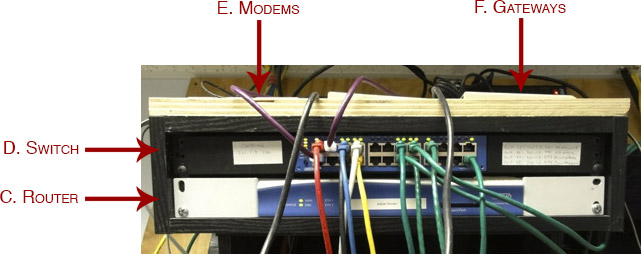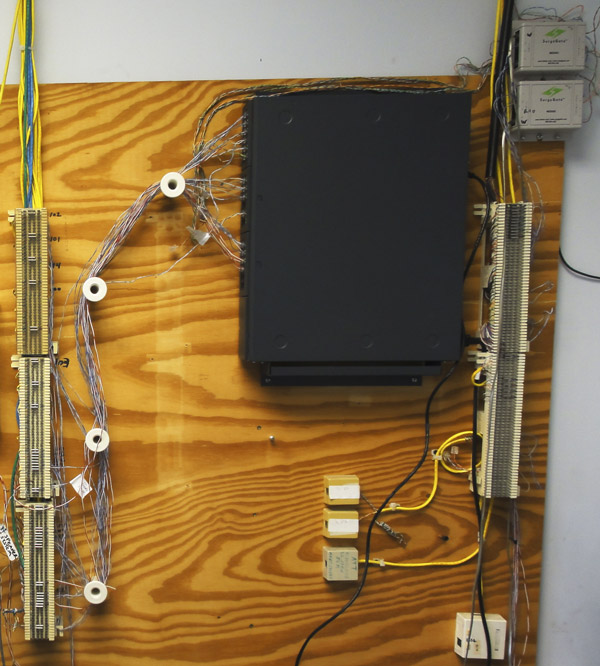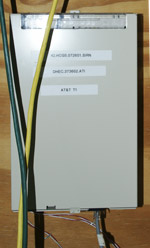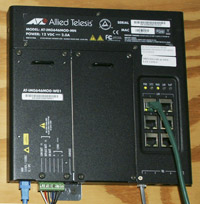Sample Photos—Computer/Communications Room Components
(Also see Computer/Communications Room, Before and After)
The computer room—often referred to as the communications room (especially if it includes the telephone PBX, which is a good practice)—is the central hub for the entire facility. As such it is especially important to have it well planned, organized, and labeled. It is routinely accessed by a variety of vendors (telephone company, telephone supplier, data carrier, Internet service provider, network engineer, computer technician, and cabling installers to name a few) and you minimize the chance of disruption if each vendor can locate and service their own hardware without accidentally disturbing equipment they are not familiar with.
It is also aptly named a "closet" in many installations, although ample (but secure) workspace is preferred to enable easy equipment access front and back, as well as to prevent overheating.
This sample computer/communications room illustrates all the major components of any small to medium business facility that needs to connect its own multiple devices (Local Area Network) to devices at one or more distant locations (Wide Area Network).
Not shown: The end-user devices, including computers, printers, telephones, scanners, fax machines, security devices, and paging speakers.

C. Wide Area Network (WAN) Router
Provides integrated capabilities needed to optimally and securely route traffic among the dedicated and Internet WAN connections and the LAN switch. Remote management enables access to this device and any connected remote management LAN switches for upgrades, programming, and troubleshooting via the Internet or emergency dial-up.
Other options include:
- Backup
- Load sharing
- Traffic prioritization
- Firewall
- Secure mobile access
- 24x7 remote monitoring
D. Local Area Network (LAN) managed switch
Provides high speed connections among all attached computers, printers, scanners, and other Ethernet-networked devices; also connects to the WAN router so that permitted devices can connect to remote LANs. A managed switch such as this is preferred to enable remote upgrades, programming, and troubleshooting via the Internet.
Other basic options include:
- Fiber optic modules for lengthy, noise-immune connections to other LAN switches.
- Power-over-Ethernet (POE) ports for voice-over-IP (VoIP) telephones, wireless access points, security cameras, and other devices.
- 24x7 remote monitoring.
- Note that a SOHO (small office/home office) may get by with the few LAN ports built into the cable or DSL modem if the extra capacity, remote management, or security is not required.
E. Dial-in analog modem(s)
- Provide emergency access to console/supervisory ports.
- Required in case of Internet access failure, or for router programming changes via command lines rather than the GUI interface.
- Uses a dedicated "POTS" line or can share the fax line by installing a manual RJ11 modular switch near the fax machine.
F. Optional WAN equipment
Includes these VoIP gateways which convert analog telephone extensions to voice-over-IP.
- VoIP connectivity among locations enables any employee to quickly reach any location with a toll-free 2-digit extension rather than calling long distance.
- The WAN router must be programmed for compatible voice prioritization to prevent excessive delay and choppiness.
H. Telephone system PBX (Private Branch Exchange)

The central cabinet that enables multiple telephones to:
(1) share outside landlines for remote connections,
(2) connect to one another within the facility (intercom), and
(3) broadcast within the facility via a paging system.
Shown with standard 66-blocks for quick punchdown of wires to telephones.
Options include:
- Routing toll-free VoIP calls via the WAN router across the dedicated circuit or Internet.
- Automatic override of paging speaker levels to ensure audible emergency announcements.





